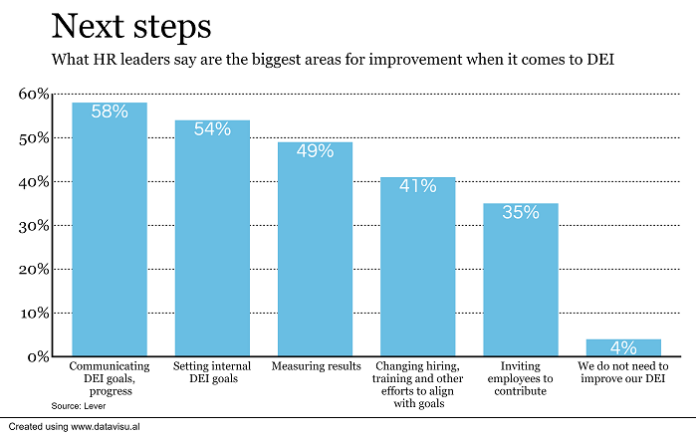We are living through a tumultuous and inspiring moment in the world of talent management. The pandemic, the Black Lives Matter protests, the shift to remote work, the Great Resignation fueling talent shortages and wage increases, and several other factors are causing a Great Reimagining of what people want from their work and their lives. HR leaders have an opportunity and a moral obligation today to capitalize on this moment by hiring and retaining more diverse teams.
It’s time to build our organizations for a new era: Diversity 2.0.
Think beyond a “pipeline problem”
In the early days of DE&I as a talent strategy, hiring managers talked about diversity as a “pipeline problem,” as if there just weren’t enough talented, qualified candidates from diverse communities. But this is the wrong way to think about diversity. The responsibility for creating a diverse workforce should not fall upon the talent themselves; it should be the job of HR leadership and employers to think creatively about how to source, identify and build relationships with diverse talent.
It’s time to name the opportunity and take responsibility for how HR leaders recruit and hire. Solve the problem by broadening the top of your funnel, aligning your sourcing efforts, expanding your hiring to new places and channels, and taking a more inclusive view of talent pedigrees.
For example, some companies are getting more proactive at recruiting people who have a prior criminal record or were formerly incarcerated; this is a talent pool that is often overlooked, and many formerly incarcerated people are from underrepresented communities.
See also: How the PGA of America expanded its diversity and inclusion
Tech companies tend to want to hire graduates from the same big-name schools, but what if you could hire someone from a trade school or from a lesser-known state school? Instead of trying to poach talent from the same prestigious tech companies, what if you could hire someone who built a career in a different industry, or who might not have every credential but has demonstrated a track record of resilience and creativity?
It’s time to get beyond the “pipeline problem” and expand your concept of what the talent bar and your pedigrees of success can look like.
Beyond hiring: ready the environment
Too often, companies have hired diverse talent but have failed to create an inclusive culture that makes diverse talent want to stay. Too often, diverse talent gets treated like canaries in a coal mine.
 HR leaders need to be proactive at readying the environment to be inclusive. If someone is the first employee from an underrepresented group to have a particular job at your company, in your department or on your team, what happens next? Do they feel valued and welcome, or do they feel uncomfortable or devalued?
HR leaders need to be proactive at readying the environment to be inclusive. If someone is the first employee from an underrepresented group to have a particular job at your company, in your department or on your team, what happens next? Do they feel valued and welcome, or do they feel uncomfortable or devalued?
If the experience of diverse talent working for your company doesn’t align with the big promises that your company has made about diversity, diverse talent will leave. And your company’s reputation will suffer.
As part of Diversity 2.0 efforts, think beyond hiring. Ready the environment within your HR department as well as your organization. Be prepared for candid discussions about your company culture, who is in the room and who is not, and how to include new hires before they arrive.
Be willing to learn from data
Diversity 2.0 is about being data-brave and learning from data to understand the full picture of your diversity efforts: who’s getting hired, who’s in your talent pipeline, who’s matriculating through the organization and getting promoted, and who’s leaving. Data can help you see the possible places in your pipeline where biases (implicit or explicit) might be driving diverse talent away.
 For example, today, many organizations should have data that can tell what percentage of diverse talent are being promoted to higher-level executive roles, and how that compares to the percentage getting hired for entry-level jobs. Is your company somehow driving away talent before they can get promoted? Is diversity being built into your succession planning for higher-level executive roles?
For example, today, many organizations should have data that can tell what percentage of diverse talent are being promoted to higher-level executive roles, and how that compares to the percentage getting hired for entry-level jobs. Is your company somehow driving away talent before they can get promoted? Is diversity being built into your succession planning for higher-level executive roles?
Related: 6 ways we’re getting diversity recruiting all wrong
Diversity 2.0 is about the total view of diverse talent at your company–not only your new hires, but the complete experience of working for your company and being part of the corporate culture. Now that we’re able to work from home, geography is less of a factor, and talent has more power to reject your offer. This moment of national reimagining is a time for HR leaders from organizations of all sizes to seize opportunities to hire, retain and benefit from the contributions of diverse talent.
Learn how emerging technology is shaping new approaches to diversity, equity and inclusion at the HR Technology Conference, Sept. 28-Oct. 1 in Las Vegas. Click here to register.





